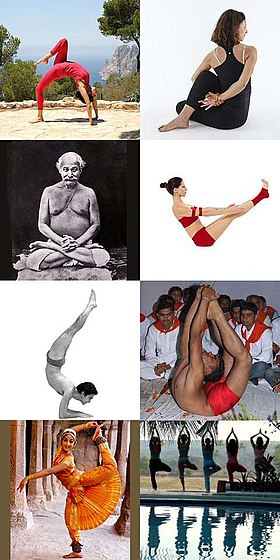
Back Asana ALS أسانا Arabic যোগাসন Bengali/Bangla Asana Catalan Ásana Czech Asana Welsh Asana German Ασάνα Greek Asano Esperanto Asana Spanish

An āsana (Sanskrit: आसन) is a body posture, originally and still a general term for a sitting meditation pose,[1] and later extended in hatha yoga and modern yoga as exercise, to any type of position, adding reclining, standing, inverted, twisting, and balancing poses. The Yoga Sutras of Patanjali define "asana" as "[a position that] is steady and comfortable".[2] Patanjali mentions the ability to sit for extended periods as one of the eight limbs of his system.[2] Asanas are also called yoga poses or yoga postures in English.
The 10th or 11th century Goraksha Sataka and the 15th century Hatha Yoga Pradipika identify 84 asanas; the 17th century Hatha Ratnavali provides a different list of 84 asanas, describing some of them. In the 20th century, Indian nationalism favoured physical culture in response to colonialism. In that environment, pioneers such as Yogendra, Kuvalayananda, and Krishnamacharya taught a new system of asanas (incorporating systems of exercise as well as traditional hatha yoga). Among Krishnamacharya's pupils were influential Indian yoga teachers including Pattabhi Jois, founder of Ashtanga vinyasa yoga, and B.K.S. Iyengar, founder of Iyengar yoga. Together they described hundreds more asanas, revived the popularity of yoga, and brought it to the Western world. Many more asanas have been devised since Iyengar's 1966 Light on Yoga which described some 200 asanas. Hundreds more were illustrated by Dharma Mittra.
Asanas were claimed to provide both spiritual and physical benefits in medieval hatha yoga texts. More recently, studies have provided evidence that they improve flexibility, strength, and balance; to reduce stress and conditions related to it; and specifically to alleviate some diseases such as asthma[3][4] and diabetes.[5]
Asanas have appeared in culture for many centuries. Religious Indian art depicts figures of the Buddha, Jain tirthankaras, and Shiva in lotus position and other meditation seats, and in the "royal ease" position, lalitasana. With the popularity of yoga as exercise, asanas feature commonly in novels and films, and sometimes also in advertising.
- ^ Verse 46, chapter II, "Patanjali Yoga sutras" by Swami Prabhavananda, published by the Sri Ramakrishna Math ISBN 978-81-7120-221-8 p. 111
- ^ a b Patanjali Yoga sutras, Book II:29, 46
- ^ Cite error: The named reference
rosswas invoked but never defined (see the help page). - ^ Cite error: The named reference
hayeswas invoked but never defined (see the help page). - ^ Cite error: The named reference
alexanderwas invoked but never defined (see the help page).
© MMXXIII Rich X Search. We shall prevail. All rights reserved. Rich X Search